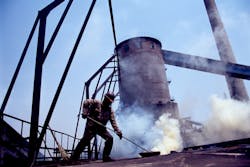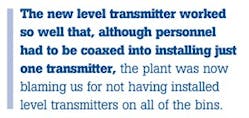As a result of my involvement with ultrasonic level measurement systems used in our iron ore beneficiation plant (described in my October Application Corner), I was asked to visit another plant that used an ultrasonic level measurement system to measure the level of hot coke in tall bins.
On Monday morning, I entered the plant and was escorted to the top of the bins. One look into a manhole in the hot coke bin revealed the magnitude of the problem: Swirling clouds of hot coke dust obstructed viewing beyond maybe 0.5 meters into the bin. We then went to the shop to examine a transducer that had already been removed from service. I took one glance at the transducer and said, “That won’t work,” to which the plant technician replied, “We know that,” followed by a gesture to escort me back to the gate.
Seeing his reaction, I asked if the plant had an ultrasonic level transmitter made by the same manufacturer whose equipment was installed in the iron ore beneficiation plant (described in October). Fortunately, there was one such transmitter in the plant that we could see in operation. After seeing the unit and describing why the new ultrasonic sensor had a much better chance of working, the plant technician agreed to try one instrument in the most difficult service — hot coke.
Making a long story short, one week later, the plant installed the ultrasonic transmitter on the hot coke bin and contracted a factory service technician to install and start it up. A week later after installation, the plant called my supervisor (by chance I was in his office) and asked when the rest of the system would be installed. The new level transmitter worked so well that, although personnel had to be coaxed into installing just one transmitter, the plant was now blaming us for not having installed level transmitters on all of the bins.
As I have suggested previously, sometimes you can look good if you are armed with the right knowledge at the right time in the right place.
David W. Spitzer is a regular contributor to Flow Control magazine and a principal in Spitzer and Boyes LLC offering engineering; seminars; strategic marketing consulting; distribution consulting; and expert witness services for manufacturing and automation companies. Spitzer and Boyes is also the publisher of the Industrial Automation INSIDER. Spitzer has more than 40 years of experience and has written more than 10 books and 300 articles about flow measurement, instrumentation and process control. He may be reached at 845-623-1830 or at spitzerandboyes.com.




